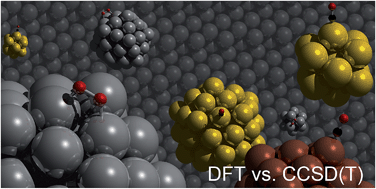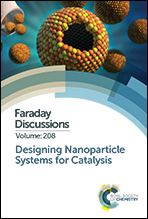CO adsorption and oxygen activation on group 11 nanoparticles – a combined DFT and high level CCSD(T) study about size effects and activation processes
Abstract
The focus of this study lies in the activation of molecular oxygen and reaction with CO within density functional theory (DFT) and high level CCSD(T) calculations. Therefore, we use M13 and M55 nanoparticles (NPs) and periodic M(321) surfaces as model systems and compare the catalytic activity of gold substrates to Ag and Cu based NP catalysts. In the first step, the adsorption energies of CO were compared for nanoparticles of different sizes for Au, Ag and Cu. The adsorption energies on M(321) and M55 NPs (M = Au, Ag, Cu) are virtually identical. For smaller M13 NPs the adsorption energies differ by ∼0.2 eV for Ag, ∼0.4 eV for Au, and ∼0.6 eV for Cu at the PBE level of theory. This can be explained by size effects, as the M13 NPs show a more molecule-like character. Presumably, CO binds more strongly to these very small NPs at the PBE level of theory. However, a benchmark calculation in the framework of CCSD(T)-theory reveals an adsorption energy of CO on Au13 of −0.88 eV, comparable to the adsorption energies calculated at the PBE level for Au55 and Au(321). For Au55, the adsorption energy calculated at the CCSD(T) level is −0.85 eV. This is in perfect agreement with the PBE result. In addition to adsorption energies, dissociation barriers have been calculated on M(321) surfaces. The dissociation energies of O2 on coinage metal catalysts are high, so that direct CO-oxidation reactions with molecular oxygen should be the dominant reaction mechanism compared to the dissociation and reaction of CO and atomic oxygen at least for silver and copper catalysts.

- This article is part of the themed collection: Designing Nanoparticle Systems for Catalysis


 Please wait while we load your content...
Please wait while we load your content...